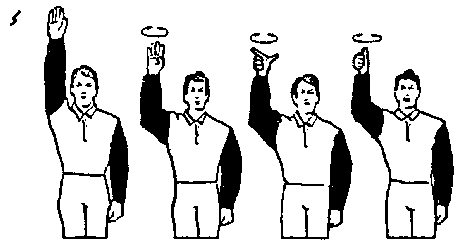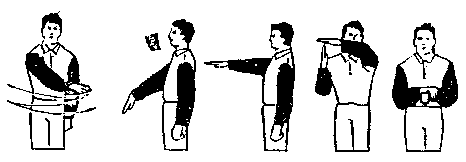Wrestlers Throw Scoring
(Figures of these techniques are included in the throwing
technique section)
- Both Wrestlers Standing
- Attacker Applies Throw Without Falling
- Defender Lands on Back or Quick Roll Over
-----Total Victory
- Defender Lands on Side
-----4 - Defender Lands on Stomach, Buttocks, Shoulder or Chest
-----2 - Defender Lands on Knee/Hands or a Hand Forearm, Takedown With
Control
-----1
- Defender Lands on Back or Quick Roll Over
- Attacker Applies Throw Without Falling
Both Wrestlers Standing
- Attacker Applies Throw With Falling
- Defender Lands on Back or Quick Roll Over
-----4 - Defender Lands on Side
-----2 - Defender Lands on Stomach, Buttocks, Shoulder or Chest
-----1 - Defender Lands on Knee/Hands or a Hand Forearm Takedown With
Control
-----1
- Defender Lands on Back or Quick Roll Over
Attacker Standing, Defender on Mat
- Attacker Applies Throw Without Falling
- Defender Lands on Back or Quick Roll Over
-----2 - Defender Lands on Stomach, Buttocks, Shoulder or Chest
------ - Defender Lands on Knee/Hands or a Hand Forearm Takedown With
Control
------
- Defender Lands on Back or Quick Roll Over
Attacker on Mat, Defender Standing or on Mat
- Attacker Applies Throw With Defender Falling
- Defender Lands on Back or Quick Roll Over
-----1 - With Lift of Opponent by Attacker Above Hips*
Defender Lands on Back or Quick Roll Over
-----2 - Defender Lands on Side
-----1 - Defender Lands on Stomach, Buttocks, Shoulder or Chest
------ - Defender Lands on Knee/Hands or a Hand Forearm Takedown With
Control
------ - * This lift criteria seems to vary between officials and countries. However, many US officials prefer to award the lift points.
- Defender Lands on Back or Quick Roll Over
Mat Technique
Wrestlers Mat Scoring
-
10 Seconds Hold Down
-----2 Hold Down Points - 20 Seconds Hold Down
-----4 Hold Down Points- Note: Only one hold down can be scored (2 or 4 point) during a match
- Painful Legal Hold
-----Total Victory (Match Award) - 12 Point Advantage
-----Match Award - First Warning
-----Verbal - First Caution
-----1 - Second Caution
-----2Third Caution
-----Match Award
Wrestling/Scoring Area
Referee Scoring Gestures and Other Signals

Left to right: Total Victory, Four Points, Two Points, One
Point.

Left to Right: Broken Hold Down or No Points, Verbal and Signal
to Watch Hold Down, Throw is on the Mat, Time Out, Illegal
Hold.
Footwork
Describing the proper footwork positions for each throw is difficult. The best advice is to watch accomplished JUDO or SOMBO wrestlers execute various throwing techniques. However, at least two maneuvers dominate most trips and one position is standard for many throws. The primary positions for throwing or tripping from your opponents right side is described below:
- Throwing T Position: step into a T position across the front
of your opponents right toes. Next, step in a backward motion
almost between your opponents feet with your left foot while
swiveling on the ball of your right foot. At the same time, bend
your knees slightly. The throw is executed with a slight bend
forward of your body and straightening the legs. Your hip should
bump your opponents body.
- Trip With Sweep: footsweeps are similar in SOMBO and
wrestling. You must step either to the side or backwards while
pulling slightly on your opponents jacket. Just as your opponent
takes his weight off his right foot, sweep his foot sideways with
your left foot while at the same time lifting is shoulders up and
twisting your body in a counter-clockwise direction.
- Trip With Kazush: pull your opponent forward and lift slightly until you slightly bump your opponents chest (kazush). At the same time step with your left foot to just to the front and about one foot to the left of your opponents right foot. Your right foot, cocked slightly inward, is moved first between your left foot and your opponents right knee, then extended inward behind your opponents right knee. Your body is pushing into your opponent right side, and as you execute the trip, you must bend forward.
Belt Requirements